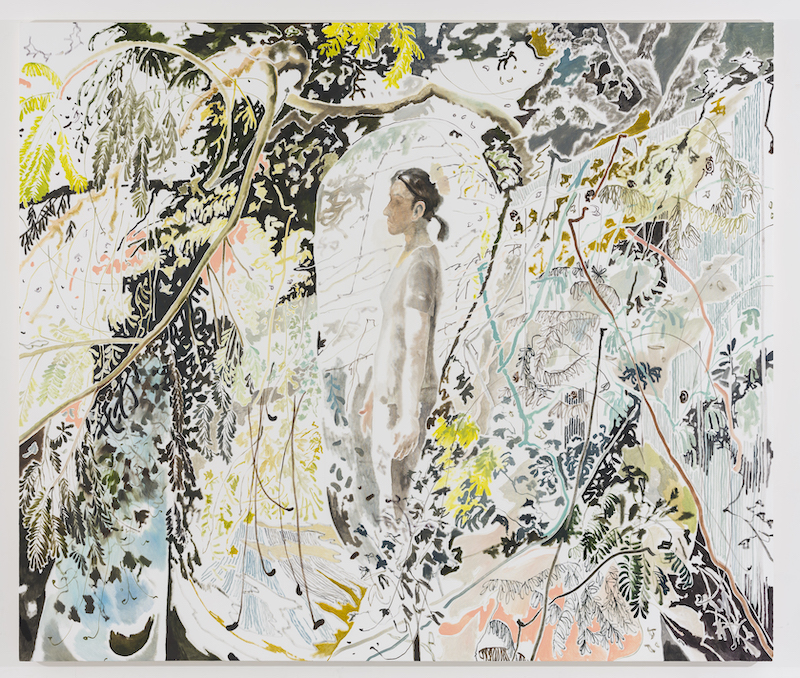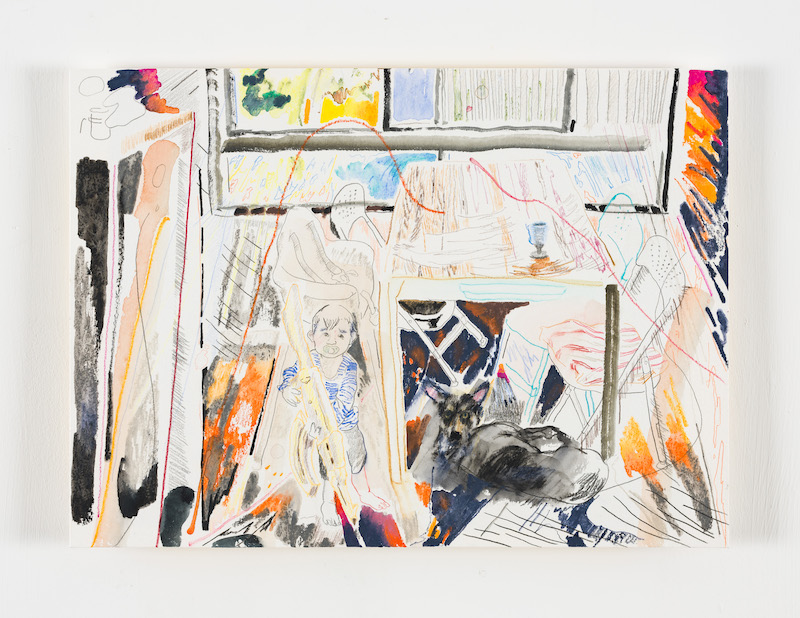Artist's Loneliness Huen Sin Kan Yu Shanqin's studio in Yuen Long does not have air conditioning, only a fan, to resist the heat of summer. The habit of not installing air conditioners originated from the studio in Tai Kok Tsui. At first, he felt that no air conditioner was more environmentally friendly. Second, he thought that using air conditioners was just a habit. From an early age, Xuan likes to have rich knowledge in research. At the university, because of the lack of interest in mixed media, I read a lot of left-wing ideological books on international situationalism in the library, and then studied how Young British Painters re-pursued tradition in an era of catching up with trends. He feels that there are rich things behind these phenomena, expositions, and cultures. However, he felt that he did not like the feeling of letting a point of view control, so after researching to a certain extent, he would transfer to other things. 
Recently, his new favorite is the pipe. Although he is a painter, what we are talking about here is not the pipe in the painter Magritte's painting, but the pipe used to light tobacco in reality. He said that at first he saw smoking pipes when he was traveling, so he later tried to make his own pipe. When learning to make pipes, I also watched short videos of different artificial pipes on YouTube, and then slowly sorted out my own method of making pipes. After starting the research, I discovered that there was a lot of knowledge. 
Painting is like math Looking at his early works, he did not use many strokes. He also often mentioned in the early days that he would think about the structure, form, and lines of the painting, and how to form the impression in the viewer's mind. In fact, his creative thinking is quite rational. In his understanding, color serves as a tool for carrying information, such as the environment that appears at night or the environment in the morning. He described that each of his works is not a conclusion, but a hypothesis. He holds a questioning mentality and constantly proves that, after completing a work, if he finds that there are still many things to be dealt with, he is motivated to start the next one. painting. He gave an example, "There is a term in the world of painting, dots, lines, and planes, but I had an eccentric assumption at the time, that in fact the world has no faces, and faces, like mathematics, were conceived by people." Although the recent works seem to have "faces" and the colors seem to be brighter than before, he insists that he understands whether those "faces" are thick lines or large dots. He tried to think about it. The change should start after he moved the studio to Yuen Long. "The structure of the observation space is different, which will affect the color. In addition, it may also be related to the rules of my life. My previous studio in Tai Kok Tsui Work, play with dogs in the morning, go to dinner, work at night, so the time of observation is morning; but after I have children, I try a working mode of operation, so the time of observation becomes night ... What I see at night is more Less, but more things you see at the same time. You focus more things, because the light source is focused on something, so the saturation of the color will be higher. "In other words, the new living environment and rhythm make the He began to establish another sensitivity to texture and light. 
Is everyday, not just everyday Many people may think that the theme of Yu Shanqin's painting is daily life. On the surface, this is indeed the case. In the early works of Xuan Shanqin, the plain scenes of life in Xuan Shanqin's paintings, the title is also simply named after the "protagonist" in the painting-such as his dog Doodood and his wife Haze. Son Joel. He borrowed David Hockney's explanation when he was asked why he painted his dog: the painting was because of Love. He painted his family because of intimacy. There are emotional factors in the family around Yu Shanqin's painting. But as an artist, it bears the brunt of how nature naturally breaks daily life and chooses objects and themes. At first glance, no matter whether it is a dog, a street after a typhoon, a tree on the road, a wife, or a son, there seems to be no criteria, and there is no hidden purpose or meaning. It can be seen that the world of Zishanqin is not "broad", and his daily life experience is his main creative resource. For Xi Shanqin, these objects are of course important. But the reason why the object image is the object image must have a certain function and meaning to a certain extent. There is a famous question in physics: When a tree falls in a lonely forest, no animals hear it nearby, does it make a sound? Therefore, when realizing the appearance of an object in daily life, the artist has taken it away from daily life. The object presented at this time can be understood as a derivative of his wife and son, which has become art itself at the same time. 
Decompose, embed, extend, return From another perspective, he draws these things to let him understand and think about the way of viewing. What he hopes to visualize is the state of people watching things everyday. He described that he would accumulate daily perceptions of things in his mind and organize them before presenting them on the canvas. He metaphorically said that he seemed to be taking a picture with his mobile phone every day in his mind. When he wanted to draw something, he kept scanning back and forth and chose one. Draw for a while, let go, draw other works, and when I come back to do it again, I might have another picture in my mind: "I hope my painting is not a visual capture, but a whole. If you are very committed to complete a picture The painting will become only one point of view, but what I want to express is not a moment, but a constant place. When I see it repeatedly, it will actually become how I understand that place. "It can be seen that his work involves two kinds of human beings. Basic experience: watch and understand. The way the work space is constructed is obviously different from the real space. The original is solid and closed, but as Xuan Shanqin said, his painting is composed of dots and lines, so no matter how dense the strokes of his recent works become, the world in the painting is still transparent. It is virtual or reshape the original space, on the other hand, it weakens or eliminates the original space. The space of his recent works began to become chaotic, which could be interpreted as his further experiments. He first stepped back to understand how people construct their cognition of space and objects, then decompose these things, re-overlap them on the canvas, and embed them into his subjective daily interpretation and interpretation. This analysis process is not dominated by the artist's sensibility, but to a certain extent is based on the habit of human perception, so it has a certain universality. He seems to increasingly emphasize the constant exchange, adjustment, and re-understanding between this vision and perception. However, to understand this perceptional viewing state, the audience must spend more time reading in addition to watching. Therefore, it is difficult to define whether Yu Shanqin's work is abstract or figurative, or that abstraction and figurative itself have overlapped and melted. There is certainly a boundary between art and life. After the formation of Yu Shanqin's works, it will become "distant" from daily life, but it just makes us more conscious of observing life itself. Knowing Destiny in 30 It is often said that it stands at thirty. Zhan Shanqin is now 28 years old. He already has a beard, is married and has children, and his life is much more mature than his actual age. It is reported that when he was in college, he already knew his creative direction and focused on development, which was earlier than graduates of the same age. He said that he has some kind of rebellion. For example, someone said that it is difficult for an artist to survive, and he will work harder to challenge. Today, his work is hot in the art market, and he even started to have a chance to exhibit in foreign galleries. His career can be said to be smooth. So, what is the next challenge? He described that when he was young, he felt that he could not control things, and he would have a spirit of challenging again. For example, he used wood color as an unsatisfactory child when he was a child, so this time he dipped the wood color in some works and used it so that it can be used like an oil bar. "One of the silly longings is that when I saw some masters or good works, it inspired me to make my own work. So every time I was depressed, I reminded myself that the work I hope to inspire the next generation People, make your own version ... to admit such a primitive, clumsy, naked desire, but to achieve a certain stage, you must admit it before you can continue to advance. " ( by https://www.cobosocial.com/dossiers/chris-huen-trees-forgotten-things/ ) |

Powered by Art Like Club © 2019-2025